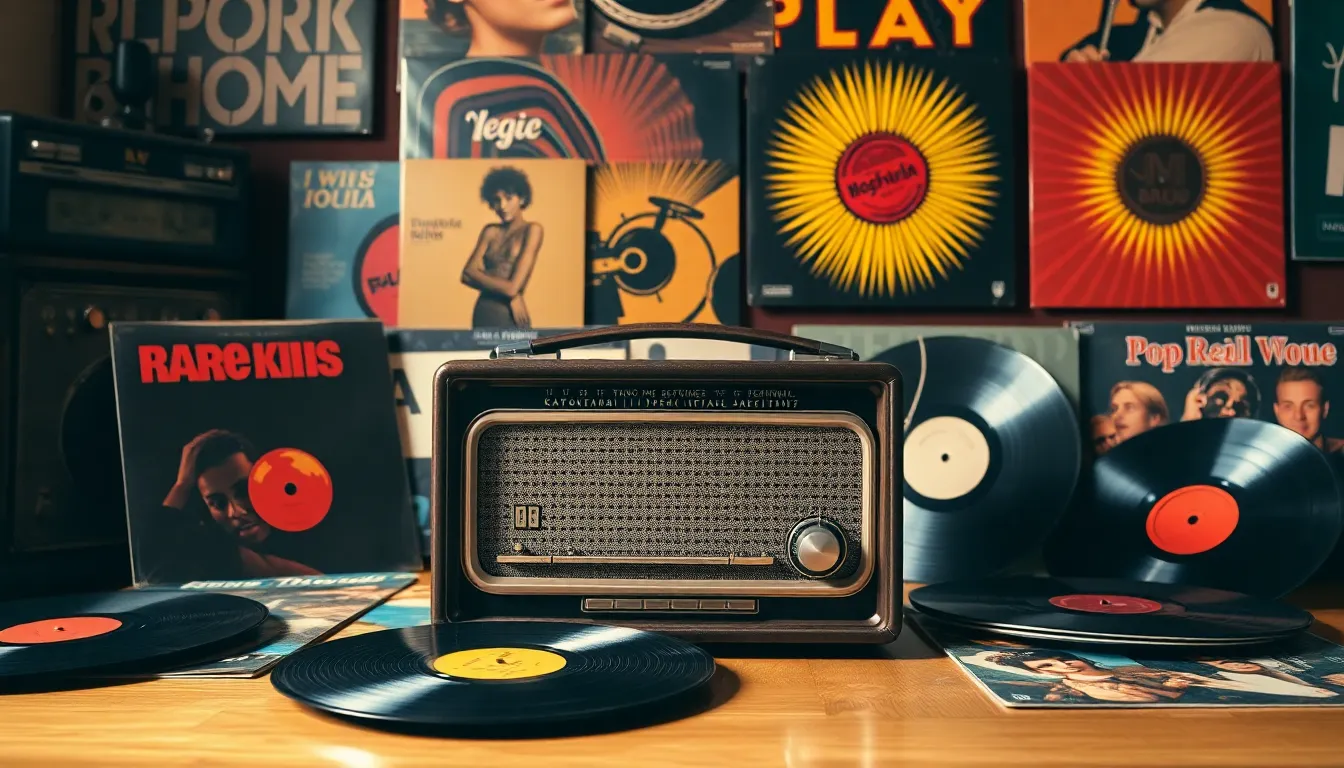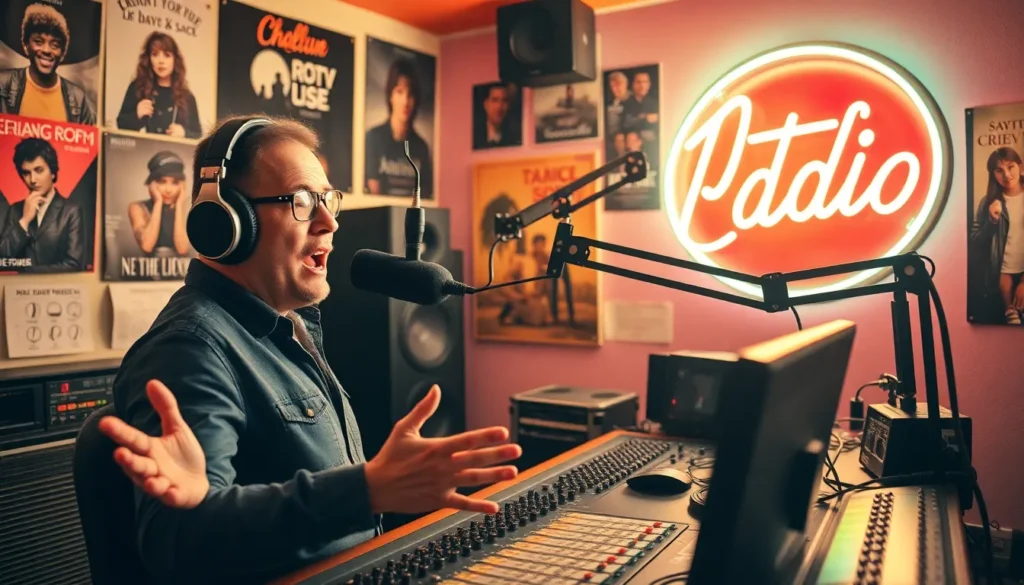Table of Contents
TogglePop music radio is the heartbeat of modern sound, pumping out catchy tunes that make even the grumpiest morning person tap their toes. From the latest chart-toppers to nostalgic throwbacks, it’s a vibrant mix that keeps listeners coming back for more. Whether you’re stuck in traffic or hosting a dance party in your living room, pop radio transforms mundane moments into unforgettable experiences.
But it’s not just about the music; it’s about the connection. Pop music radio brings people together, creating a shared soundtrack for life’s highs and lows. With lively hosts and engaging segments, it’s like having a personal DJ who knows just how to lift your spirits. So, turn up the volume and dive into the world of pop music radio—it’s time to discover why this genre remains a fan favorite and a cultural phenomenon.
Overview of Pop Music Radio
Pop music radio plays a crucial role in shaping contemporary culture. It delivers catchy tunes that uplift everyday experiences, whether during commutes or social gatherings. Many listeners connect with the shared soundtrack it creates, which unites them through specific life moments. Engaging hosts lead lively segments that enhance the listening experience.
Listeners often enjoy diverse genres within the pop category, including dance-pop, synth-pop, and teen pop. Stations curate playlists featuring top charts, providing access to current hits and emerging artists. Regular updates keep content fresh, ensuring the audience stays engaged.
Pop music radio also builds a sense of community. Through online platforms and social media, listeners interact with each other and share their favorite songs. This interaction fosters deeper connections and enhances the experience of listening.
The dynamic nature of pop music radio allows it to adapt to trends quickly. Stations often feature exclusive interviews with artists, allowing fans to gain insights behind the music. Such content fosters loyalty among listeners, who appreciate the behind-the-scenes perspective.
In many regions, pop music radio remains a favorite genre, driving listener numbers significantly. Statistics show that over 80% of Americans listen to the radio weekly, with a substantial share tuning into pop stations. By creating an enjoyable atmosphere, pop music radio solidifies its position as a beloved and influential medium in modern society.
History of Pop Music Radio

Pop music radio has significantly evolved, reflecting broader cultural changes. The evolution began in the 1950s with the advent of rock and roll, as stations shifted toward a more youth-oriented sound, revolutionizing listening habits.
Evolution Through the Decades
In the 1960s, DJs began to dominate the airwaves, engaging audiences with personal styles. The 1970s saw the rise of disco, influencing playlists and promoting club culture. During the 1980s, the introduction of MTV changed how pop music reached listeners, connecting visuals to hits. The 1990s embraced boy bands and pop princesses, creating mega stars and global phenomena. By the 2000s, digital platforms emerged, allowing pop radio to cater to diverse tastes while proliferating playlists.
Impact of Technology on Broadcasting
Advancements in technology transformed how pop music radio operates. The launch of FM radio provided better sound quality and allowed more stations to reach listeners. Satellite radio introduced numerous channels, expanding options for pop music fans. Streaming services further revolutionized access, enabling on-demand listening and personalized playlists. Data analytics now inform programming decisions, helping stations tailor content to listener preferences.
Popularity of Pop Music Radio
Pop music radio remains a staple in many people’s lives. Its widespread appeal resonates with diverse demographics, from teens to adults.
Demographics of Listeners
Listeners of pop music radio span various age groups, but the core audience typically includes those aged 18 to 34. This group connects deeply with current trends, creating an environment ripe for discovering new artists. Women often represent a larger proportion of listeners, drawn to relatable lyrics and catchy melodies. Statistically, over 75% of this demographic tunes in weekly, showcasing how pop music radio holds significant influence. Younger audiences gravitate towards online platforms, while older listeners appreciate traditional broadcasts, allowing for a broad reach. Overall, the diverse listener profile enhances pop radio’s cultural impact.
Key Factors Driving Popularity
Several factors contribute to the popularity of pop music radio. Engaging hosts attract listeners through lively chatter and personal stories. Additionally, live performances and exclusive interviews create excitement around new releases. Stations frequently update playlists to feature trending songs, ensuring fresh content that resonates with audiences. Social media platforms further amplify this dynamic, as fans share favorite tracks and interact with artists. Furthermore, targeted advertising appeals to specific listener interests, enhancing connection. These elements cultivate loyalty, establishing pop music radio as a leading choice in entertainment.
Notable Pop Music Radio Stations
Pop music radio features several significant stations that shape listeners’ experiences. These stations vary by region and have distinct characteristics.
Regional Highlights
In the United States, local pop stations offer unique insights into regional sounds. For instance, Los Angeles FM 102.7 features trending hits and artist interviews, attracting listeners eager for new content. Meanwhile, New York’s Z100 showcases a mix of mainstream hits and emerging artists, appealing to a diverse audience. Chicago’s 103.5 KISS FM focuses on today’s top tracks, engaging younger demographics with lively on-air personalities. These stations reflect regional tastes while upholding pop music’s universal appeal.
National Trends
Nationally, major pop radio networks dominate the landscape. iHeartRadio’s Top 40 stations cater to listeners across the country, presenting a blend of popular tracks. This network showcases artists like Taylor Swift and Ed Sheeran with high chart performances. Additionally, SiriusXM’s Pop Hits offers curated playlists and exclusive artist content, enhancing engagement for subscribers. Over 80% of Americans tuning into the radio weekly demonstrates pop music’s widespread appeal. These trends emphasize pop music radio’s vital role in shaping contemporary culture, connecting listeners with their favorite genres and artists.
Future of Pop Music Radio
Pop music radio is poised for significant transformation driven by technology and evolving audience expectations. Stations adapt quickly to digital trends, ensuring they remain relevant in a competitive landscape.
Emerging Technologies
Streaming platforms reshape pop music radio, offering personalized playlists and on-demand access to songs. Smart speakers and mobile apps enhance user interactions, allowing seamless transitions between live radio and curated experiences. Innovations in artificial intelligence assist in analyzing listener preferences, tailoring content specifically to individual tastes. These advancements not only improve sound quality but also facilitate better artist-audience connections. Statistics indicate that 70% of listeners favor platforms that integrate personalized recommendations, highlighting the demand for these technologies.
Changing Listener Preferences
Listener preferences continually shift, emphasizing the importance of engaging content. The younger demographic, particularly ages 18 to 34, favors interactive experiences that social media provides. They often seek authenticity, gravitating toward artists who share personal stories and connect on a deeper level. Data reveals that 65% of pop music radio listeners enjoy live performances and behind-the-scenes content. Stations that prioritize these elements cultivate loyalty, attracting an audience that celebrates not just the music but the experiences surrounding it.
Pop music radio continues to thrive as a vital part of modern culture. Its ability to connect listeners through shared experiences and catchy melodies makes it a beloved medium. As technology evolves and audience preferences shift, pop radio adapts by embracing new platforms and interactive content.
With a strong focus on community engagement and personalized experiences, it remains a powerful force in the entertainment landscape. The future of pop music radio looks promising as it seeks to innovate while staying true to its roots, ensuring that it remains relevant for generations to come.





